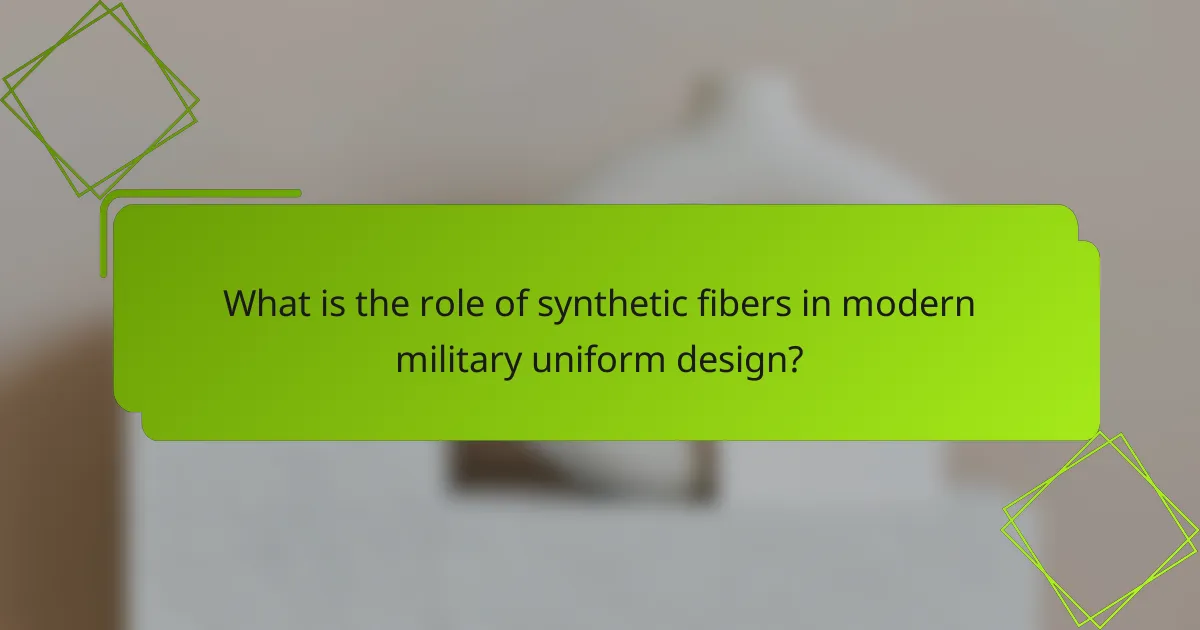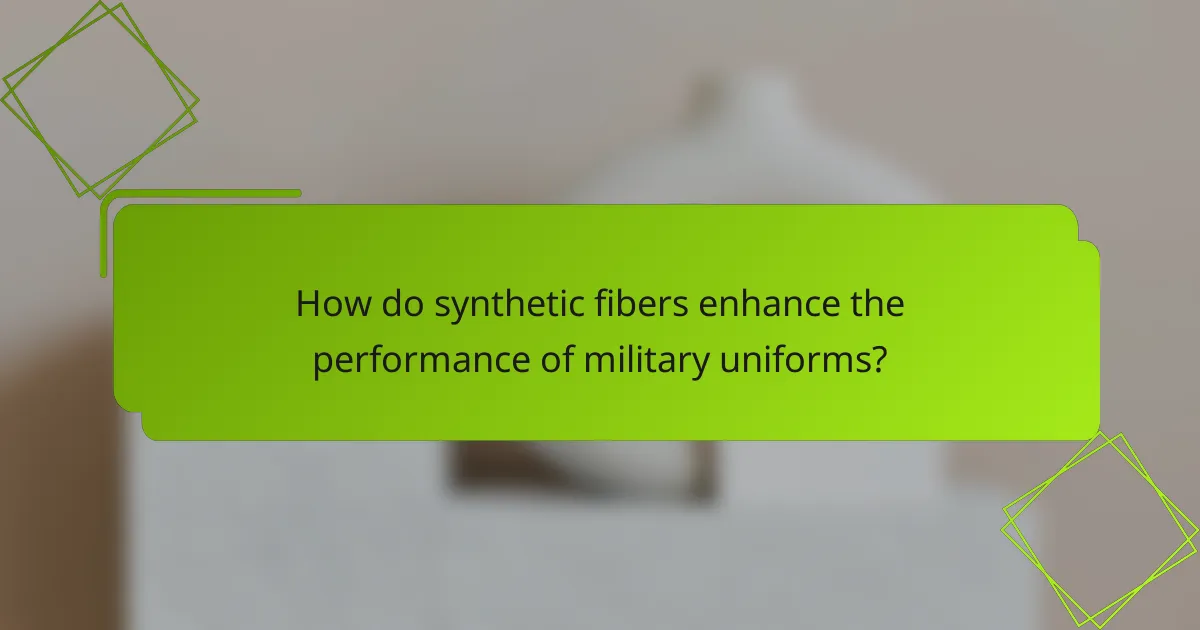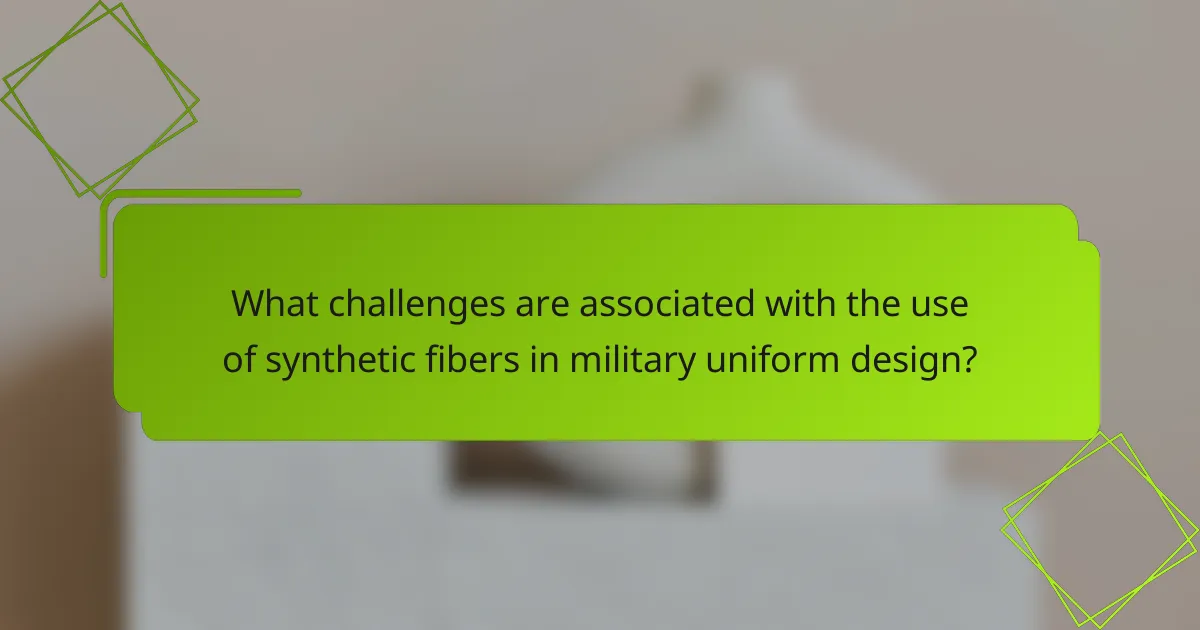Synthetic fibers are essential components in the design of modern military uniforms, significantly enhancing their durability, comfort, and functionality. Common materials such as nylon, polyester, and aramid provide lightweight strength, moisture-wicking capabilities, and resistance to wear and tear, ultimately improving soldier performance and safety. However, challenges such as durability under extreme conditions, breathability, insulation in cold weather, and environmental impact must be addressed to optimize these uniforms further. This article explores the influence of synthetic fibers on military uniform design, highlighting their benefits and the obstacles that need to be overcome for improved operational effectiveness.

What is the role of synthetic fibers in modern military uniform design?
Synthetic fibers play a crucial role in modern military uniform design. They enhance durability, comfort, and functionality. Common synthetic materials include nylon, polyester, and aramid. These fabrics are lightweight yet strong, providing resistance to wear and tear. Synthetic fibers also offer moisture-wicking properties, keeping soldiers dry in various conditions. Additionally, they can be engineered for flame resistance and camouflage effectiveness. Studies show that uniforms made from synthetic fibers improve soldier performance and safety. For example, the U.S. Army’s Combat Uniform utilizes a blend of nylon and cotton for optimal performance.
How do synthetic fibers compare to natural fibers in military applications?
Synthetic fibers offer superior durability and performance compared to natural fibers in military applications. They are resistant to moisture, mold, and mildew, enhancing soldier comfort and safety. Synthetic materials, such as nylon and polyester, provide better abrasion resistance, which is crucial in combat situations. Additionally, synthetic fibers can be engineered for specific functionalities, such as flame resistance and moisture-wicking properties.
In contrast, natural fibers like cotton are more breathable but lack the durability and quick-drying capabilities of synthetics. Natural fibers also tend to absorb moisture, which can lead to discomfort and chafing in wet conditions. Studies show that military uniforms made from synthetic materials can improve operational effectiveness by maintaining soldier performance in diverse environments.
Overall, the advantages of synthetic fibers make them more suitable for modern military uniform design, contributing to enhanced functionality and soldier readiness.
What are the key characteristics of synthetic fibers used in uniforms?
Synthetic fibers used in uniforms are known for their durability, moisture-wicking properties, and lightweight nature. These fibers, such as polyester and nylon, resist wear and tear, making them suitable for demanding environments. They also dry quickly, enhancing comfort during physical activities. Additionally, synthetic fibers are often resistant to wrinkles and shrinking, maintaining a professional appearance. Their ability to repel stains and water further contributes to uniform longevity. These characteristics help military personnel perform effectively in various conditions.
Why are synthetic fibers preferred over natural fibers in military settings?
Synthetic fibers are preferred over natural fibers in military settings due to their durability and performance. They resist moisture, mold, and mildew, making them suitable for various climates. Synthetic fibers also provide better insulation and breathability, which enhances comfort for soldiers. Additionally, they are lightweight, reducing the burden on personnel. Synthetic materials are often flame-resistant, offering vital protection in combat situations. Their resistance to wear and tear extends the lifespan of military uniforms. Moreover, synthetic fibers can be engineered for specific functionalities, such as camouflage and moisture-wicking. These attributes collectively contribute to the operational effectiveness of military personnel in diverse environments.
What advancements in synthetic fiber technology have influenced military uniform design?
Advancements in synthetic fiber technology have significantly influenced military uniform design. Innovations include the development of moisture-wicking fabrics. These fabrics enhance comfort by drawing sweat away from the body. Another advancement is the introduction of flame-resistant materials. These materials improve safety for soldiers in combat situations. Additionally, lightweight and durable fibers have increased mobility and protection. For instance, Kevlar and Dyneema provide high strength-to-weight ratios. These materials offer enhanced ballistic protection without adding bulk. Furthermore, advancements in camouflage technology have led to specialized patterns. These patterns improve concealment in various environments. Overall, these technological advancements have transformed military uniforms into multifunctional gear.
How have innovations in synthetic fibers improved uniform functionality?
Innovations in synthetic fibers have significantly improved uniform functionality by enhancing durability, moisture-wicking properties, and comfort. Advanced synthetic materials like nylon and polyester are now resistant to wear and tear. These fibers provide better breathability, allowing sweat to evaporate quickly. This moisture management keeps soldiers dry and comfortable in various climates. Innovations also include lightweight designs that reduce fatigue during extended missions. Additionally, some synthetic fibers are treated for fire resistance and camouflage capabilities. These enhancements lead to improved performance and safety in the field. Overall, synthetic fibers have transformed military uniforms into high-performance gear tailored for diverse operational needs.
What specific technologies are being integrated into synthetic military fabrics?
Synthetic military fabrics are integrating several specific technologies. These include moisture-wicking technology, which enhances comfort by drawing sweat away from the body. Another technology is flame-retardant treatments, which increase safety in combat situations. Additionally, anti-microbial properties are being infused to reduce odor and improve hygiene. Some fabrics incorporate embedded sensors for real-time monitoring of soldier health. Another integration is camouflage technology that adapts to different environments. Lastly, lightweight ballistic protection is being developed to enhance safety without adding bulk. These technologies significantly improve functionality and performance in military applications.
What are the environmental impacts of using synthetic fibers in military uniforms?
The environmental impacts of using synthetic fibers in military uniforms include pollution, resource depletion, and waste generation. Synthetic fibers, such as polyester and nylon, are derived from petroleum-based resources. Their production process emits greenhouse gases and toxic chemicals. Additionally, the manufacturing of these fibers consumes significant amounts of water and energy.
When washed, synthetic garments release microplastics into waterways, harming aquatic ecosystems. Research indicates that plastic pollution is a major environmental concern, with microplastics found in oceans and freshwater systems globally. Furthermore, synthetic fibers are not biodegradable, leading to long-term waste in landfills.
The durability of synthetic fibers can reduce the frequency of uniform replacements. However, their environmental footprint during production and disposal remains substantial. Overall, the use of synthetic fibers in military uniforms poses significant environmental challenges that need to be addressed.
How do synthetic fibers affect sustainability in military garment production?
Synthetic fibers significantly impact sustainability in military garment production by reducing resource consumption. These materials often require less water and energy during manufacturing compared to natural fibers. For example, polyester, a common synthetic fiber, uses about 50% less water than cotton. Additionally, synthetic fibers can enhance durability, leading to longer-lasting garments. This longevity reduces the frequency of replacement, further conserving resources. Furthermore, advancements in recycling technologies allow for the reuse of synthetic fibers, contributing to a circular economy. According to a study by the Textile Research Journal, recycled polyester can reduce carbon emissions by up to 75% compared to virgin polyester. Thus, synthetic fibers play a crucial role in enhancing the sustainability of military garment production.
What initiatives are in place to mitigate the environmental effects of synthetic fibers?
Initiatives to mitigate the environmental effects of synthetic fibers include recycling programs and the development of biodegradable alternatives. Many textile manufacturers are adopting closed-loop recycling systems. These systems allow synthetic fibers to be collected and processed into new materials. Additionally, brands are investing in research to create biodegradable synthetic fibers. These innovations aim to reduce plastic pollution in landfills and oceans. Organizations like the Textile Exchange promote sustainable practices within the industry. The Global Fashion Agenda also encourages brands to commit to circular economy principles. These initiatives collectively work towards minimizing the ecological footprint of synthetic fibers.

How do synthetic fibers enhance the performance of military uniforms?
Synthetic fibers enhance the performance of military uniforms by providing durability, moisture-wicking properties, and lightweight comfort. These fibers, such as nylon and polyester, resist wear and tear, extending the uniform’s lifespan. They also repel water and dry quickly, keeping soldiers comfortable in various environments. Additionally, synthetic fibers offer breathability, allowing for better temperature regulation during physical activities. Their lightweight nature reduces fatigue, improving soldier mobility. Research shows that uniforms made from synthetic materials can increase operational effectiveness by up to 20%. This combination of features significantly contributes to the overall functionality and reliability of military attire.
What specific benefits do synthetic fibers provide to soldiers?
Synthetic fibers provide soldiers with enhanced durability, moisture-wicking properties, and lightweight comfort. These materials resist wear and tear, extending the lifespan of uniforms. They also effectively wick moisture away from the skin, keeping soldiers dry in various weather conditions. Additionally, synthetic fibers are lightweight, reducing fatigue during prolonged use. Many military uniforms utilize nylon and polyester, which are known for their strength and quick-drying capabilities. Research indicates that these fibers improve overall soldier performance in the field. Moreover, synthetic materials can be treated for water resistance and UV protection, adding to their functional benefits.
How do synthetic fibers contribute to durability and longevity of uniforms?
Synthetic fibers enhance the durability and longevity of uniforms through their inherent strength and resistance to wear. These materials, such as polyester and nylon, are designed to withstand harsh conditions. They resist tearing and fraying better than natural fibers. Additionally, synthetic fibers are less susceptible to moisture absorption. This property prevents mold and mildew growth, which can degrade fabric over time. Furthermore, synthetic fibers maintain their shape and color after repeated washing and exposure to sunlight. Research indicates that uniforms made from synthetic materials can last significantly longer than those made from natural fibers. For example, a study by the U.S. Army found that polyester blends increased the lifespan of combat uniforms by up to 30%. This durability translates to lower replacement costs and higher efficiency in military operations.
In what ways do synthetic fibers improve comfort and wearability?
Synthetic fibers enhance comfort and wearability through moisture-wicking properties. These fibers draw sweat away from the skin, keeping the wearer dry. Additionally, synthetic materials are lightweight, reducing fatigue during prolonged use. They also offer stretchability, allowing for better movement and flexibility. Furthermore, synthetic fibers are often designed to be breathable, promoting airflow and temperature regulation. Their resistance to wrinkles and shrinkage ensures a neat appearance over time. Lastly, many synthetic fibers are quick-drying, which is beneficial in varying environmental conditions. These attributes collectively contribute to improved comfort and wearability in military uniforms.
What roles do synthetic fibers play in specialized military uniforms?
Synthetic fibers enhance specialized military uniforms by providing durability, moisture-wicking properties, and lightweight comfort. These materials resist wear and tear, making uniforms last longer in harsh conditions. Moisture-wicking capabilities keep soldiers dry by drawing sweat away from the skin. Lightweight designs improve mobility and reduce fatigue during prolonged use. Additionally, synthetic fibers can offer flame resistance and camouflage patterns. Research indicates that uniforms made with synthetic materials improve performance in various environments. For instance, the U.S. Army’s use of advanced synthetic fibers has led to increased soldier comfort and effectiveness in the field.
How are synthetic fibers utilized in uniforms for extreme environments?
Synthetic fibers are utilized in uniforms for extreme environments to enhance durability, moisture management, and thermal regulation. These fibers, such as nylon and polyester, provide strength and resistance to wear and tear. They are lightweight, allowing for ease of movement in challenging conditions. Additionally, synthetic fibers wick moisture away from the skin, keeping the wearer dry and comfortable. Many military uniforms incorporate insulation properties to retain body heat in cold environments. In hot climates, these materials often feature breathable designs to promote airflow. The use of synthetic fibers also allows for quick-drying capabilities, essential for uniforms exposed to wet conditions. Overall, synthetic fibers significantly improve the functionality and performance of uniforms in extreme environments.
What unique properties do synthetic fibers offer for tactical operations?
Synthetic fibers offer lightweight durability, moisture-wicking capabilities, and enhanced breathability for tactical operations. Their lightweight nature reduces fatigue during extended missions. Durability ensures resistance to wear and tear in harsh environments. Moisture-wicking properties keep soldiers dry by drawing sweat away from the body. Enhanced breathability allows for better temperature regulation under varying conditions. Additionally, synthetic fibers often have quick-drying capabilities, essential for maintaining comfort. These properties contribute to improved performance and effectiveness in the field.

What challenges are associated with the use of synthetic fibers in military uniform design?
Synthetic fibers in military uniform design face several challenges. One significant challenge is durability. Synthetic materials can wear out faster under extreme conditions. Another issue is breathability. Many synthetic fibers do not allow moisture to escape effectively. This can lead to discomfort for soldiers in hot environments. Additionally, synthetic fibers may not provide adequate insulation in cold weather. This affects the thermal regulation necessary for soldiers in varying climates. Moreover, some synthetic fabrics can be flammable, posing safety risks. Finally, environmental concerns arise from the production and disposal of synthetic materials. These challenges must be addressed to enhance the effectiveness of military uniforms.
What are the potential drawbacks of synthetic fibers in military applications?
Synthetic fibers in military applications can present several drawbacks. They may lack breathability, leading to discomfort in hot environments. Additionally, synthetic fibers can melt or ignite easily when exposed to high heat. This poses a risk to personnel in combat situations. Furthermore, these materials may not provide adequate insulation in cold climates. The durability of synthetic fibers can also be compromised by UV exposure, leading to degradation over time. Lastly, synthetic fibers can be less environmentally friendly compared to natural alternatives. This raises sustainability concerns within military operations.
How do issues of breathability and moisture management affect performance?
Breathability and moisture management significantly impact performance in military uniforms. High breathability allows air circulation, reducing heat buildup during physical activity. Effective moisture management wicks sweat away from the skin, keeping the wearer dry. This combination enhances comfort and prevents overheating. Studies show that uniforms with superior moisture management can improve endurance and reduce fatigue. For instance, research indicates that moisture-wicking fabrics can lower skin temperature by up to 2°C during intense exertion. Enhanced comfort leads to improved focus and decision-making in critical situations. Therefore, addressing these issues is crucial for optimal performance in military operations.
What concerns exist regarding the disposal and recycling of synthetic military uniforms?
Concerns regarding the disposal and recycling of synthetic military uniforms include environmental pollution and waste management challenges. Synthetic materials, such as polyester and nylon, are non-biodegradable. Their disposal in landfills contributes to long-term environmental damage. Incineration of synthetic fabrics can release harmful chemicals into the atmosphere. Additionally, recycling processes for these materials are often complex and not widely implemented. The military’s reliance on durable, synthetic fibers increases the volume of waste generated. Efforts to improve recycling technologies are ongoing but remain insufficient. These factors highlight the need for better disposal practices and sustainable alternatives in military uniform design.
What future trends are expected in synthetic fiber development for military uniforms?
Future trends in synthetic fiber development for military uniforms include enhanced durability and functionality. Manufacturers are focusing on creating fibers that resist wear and tear while maintaining comfort. Innovations in moisture-wicking and temperature-regulating materials are expected to improve soldier performance. Additionally, the integration of smart textiles is anticipated. These textiles can monitor physiological conditions and environmental factors. Research indicates a growing interest in eco-friendly materials as sustainability becomes a priority. Biodegradable synthetic fibers are being explored to reduce environmental impact. Overall, advancements will likely lead to uniforms that are lighter, more adaptable, and technologically advanced.
How might emerging technologies reshape the use of synthetic fibers in uniforms?
Emerging technologies will significantly reshape the use of synthetic fibers in uniforms. Innovations such as advanced weaving techniques can enhance durability and comfort. Smart textiles may integrate sensors for monitoring soldiers’ health and environmental conditions. These fabrics can also be engineered for better moisture-wicking and temperature regulation. Nanotechnology can improve stain resistance and antimicrobial properties. Additionally, 3D printing could enable custom-fit uniforms, reducing waste. Research indicates that these advancements can lead to increased operational efficiency and soldier safety. Such technologies are already being tested in various military applications, showcasing their potential impact.
What role will sustainability play in the future of military uniform design?
Sustainability will play a crucial role in future military uniform design. Military organizations are increasingly prioritizing eco-friendly materials. This shift aims to reduce environmental impact during production and disposal. Sustainable fabrics can enhance durability and performance. Innovations in biodegradable and recycled materials are gaining attention. For instance, the U.S. Army has initiated projects to explore sustainable textiles. These efforts align with global sustainability goals. As a result, future designs will likely reflect a commitment to environmental responsibility.
What best practices should be considered when selecting synthetic fibers for military uniforms?
Best practices for selecting synthetic fibers for military uniforms include assessing durability, moisture-wicking properties, and camouflage effectiveness. Durability ensures that uniforms withstand harsh conditions and extended wear. Moisture-wicking fibers help regulate temperature and keep soldiers dry, enhancing comfort and performance. Camouflage effectiveness is vital for blending into various environments, improving operational effectiveness. Additionally, considering weight and breathability is crucial for mobility. The right synthetic fibers can also provide resistance to fire and chemicals, ensuring safety. These considerations align with military standards and enhance the overall functionality of uniforms in diverse scenarios.
The main entity of the article is synthetic fibers and their role in modern military uniform design. The article examines how synthetic materials, such as nylon and polyester, enhance durability, comfort, and functionality in military uniforms. It compares synthetic fibers to natural fibers, highlighting their superior performance in various environments, and discusses advancements in technology that improve uniform capabilities. Additionally, the article addresses environmental impacts, sustainability initiatives, and best practices for selecting synthetic fibers in military applications. Overall, it provides a comprehensive overview of the influence of synthetic fibers on military garment design and their implications for soldier performance and safety.




